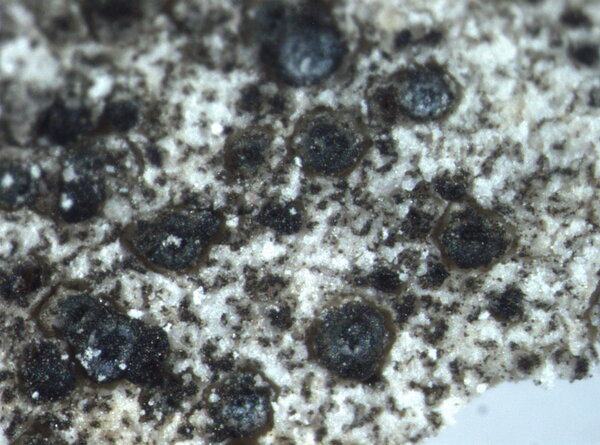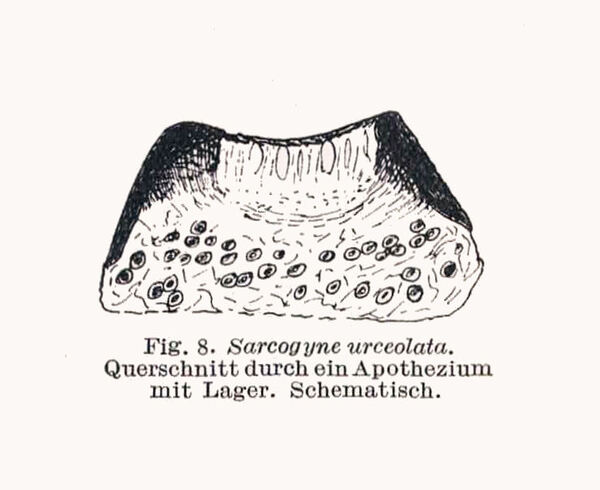Sarcogyne urceolata Anzi
Comm. Soc. Critt. Ital., 1, 3: 157, 1862.
Synonyms: Acarospora urceolata (Anzi) Jatta; Biatorella urceolata (Anzi) J. Steiner; Polysporina urceolata (Anzi) Brodo; Sarcogyne urceolata var. herpes Norman
Description: Thallus crustose, endosubstratic, not evident. Apothecia lecideine, black, round, dispersed, immersed in the rock, 0.2-0.3(-0.5) mm across, with a mostly concave, punctiform disc and a rugulose-furrowed proper margin. Proper exciple carbonized in outer part, black within, continuous with the hypothecium; epithecium dark brown; hymenium colourless, 50-80 μm high; paraphyses simple or branched in upper part, coherent (becoming lax in K), (1.5-)2-2.5(-3) μm thick at mid-level, the apical cells unexpanded or to 3 μm wide, occasionally with pigmented caps; hypothecium continuous with vegetative hyphae. Asci 100-200-spored, strongly thickened at apex, the apical dome K/I-, the outer coat K/I+ blue. Ascospores 1-celled, hyaline, ellipsoid to broadly ellipsoid, 3-5 x (1.5-)2-3 μm. Photobiont chlorococcoid. Spot tests: thallus K-, C-, KC-, P-, UV-. Chemistry: without lichen substances.
Growth form: Crustose endolithic
Substrata: rocks
Photobiont: green algae other than Trentepohlia
Reproductive strategy: mainly sexual
Commonnes-rarity: (info)
Alpine belt: very rare
Subalpine belt: rare
Montane belt: extremely rare
Dry submediterranean belt: absent
Humid submediterranean belt: absent
Padanian area: absent
pH of the substrata:
1 2 3 4 5
Solar irradiation:
1 2 3 4 5
Aridity:
1 2 3 4 5
Eutrophication:
1 2 3 4 5
Poleotolerance:
0 1 2 3
Altitudinal distribution:
1 2 3 4 5 6
Rarity
absent
extremely rare
very rare
rare
rather rare
rather common
common
very common
extremely common
Loading data...
Occurrence data
Predictive map
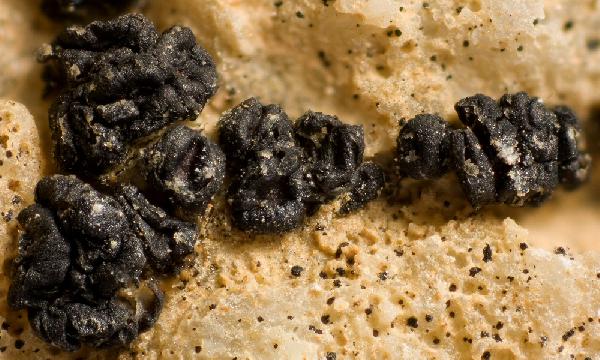
Ulrich Kirschbaum CC BY-SA 4.0 - Source: https://www.thm.de/lse/ulrich-kirschbaum/flechtenbilder
Kurdish region of Iran. (Identified by H. Sipman)
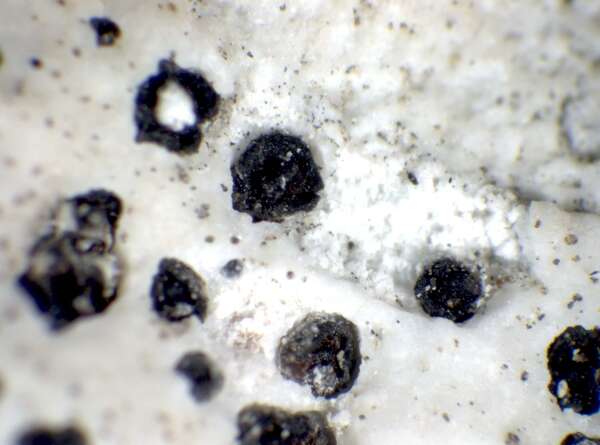
P.L. Nimis; Owner: Department of Life Sciences, University of Trieste
Herbarium: TSB (25101)
2001/11/29
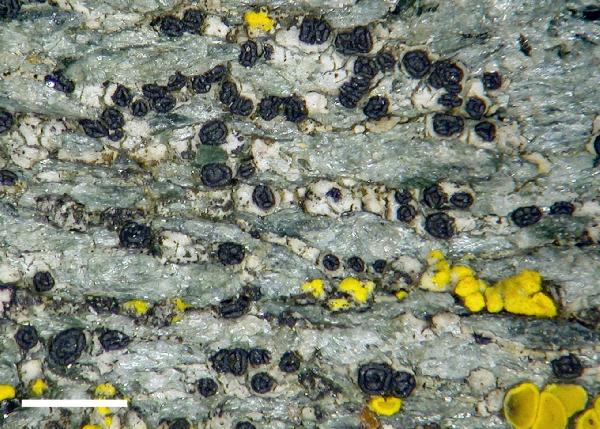
Source: Thor, G., Arup, U., Frisch, A., Grube, M., Vicente, R. & Westberg, M. 2023. Padjelanta National Park in Sweden, a lichen diversity heaven. Graphis Scripta 35 (7): 81–125. Oslo. ISSN 2002-4495. - CC BY-4.0
apothecia growing on Candelariella aurella. M. Westberg 08-260 (SF123679). Scale bar: 1 mm. Photo M. Westberg
Growth form: Crustose endolithic
Substrata: rocks
Photobiont: green algae other than Trentepohlia
Reproductive strategy: mainly sexual
Commonnes-rarity: (info)
Alpine belt: very rare
Subalpine belt: rare
Montane belt: extremely rare
Dry submediterranean belt: absent
Humid submediterranean belt: absent
Padanian area: absent
pH of the substrata:
| 1 | 2 | 3 | 4 | 5 |
Solar irradiation:
| 1 | 2 | 3 | 4 | 5 |
Aridity:
| 1 | 2 | 3 | 4 | 5 |
Eutrophication:
| 1 | 2 | 3 | 4 | 5 |
Poleotolerance:
| 0 | 1 | 2 | 3 |
Altitudinal distribution:
| 1 | 2 | 3 | 4 | 5 | 6 |
Rarity
absent
extremely rare
very rare
rare
rather rare
rather common
common
very common
extremely common
Loading data...
Occurrence data
Predictive map

Ulrich Kirschbaum CC BY-SA 4.0 - Source: https://www.thm.de/lse/ulrich-kirschbaum/flechtenbilder
Kurdish region of Iran. (Identified by H. Sipman)

P.L. Nimis; Owner: Department of Life Sciences, University of Trieste
Herbarium: TSB (25101)
2001/11/29



